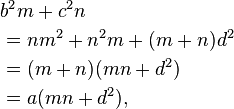Stewart's theorem
In geometry, Stewart's theorem yields a relation between a lengths of the sides of the triangle and the length of a cevian of the triangle. Its name is in honor of the Scottish mathematician Matthew Stewart who published the theorem in 1746.[1]
Theorem
Let  ,
,  , and
, and  be the lengths of the sides of a triangle. Let
be the lengths of the sides of a triangle. Let  be the length of a cevian to the side of length
be the length of a cevian to the side of length  . If the cevian divides
. If the cevian divides  into two segments of length
into two segments of length  and
and  , with
, with  adjacent to
adjacent to  and
and  adjacent to
adjacent to  , then Stewart's theorem states that
, then Stewart's theorem states that
Apollonius' theorem is the special case where d is the length of the Median.
The theorem may be written somewhat more symmetrically using signed lengths of segments, in other words the length AB is taken to be positive or negative according to whether A is to the left or right of B in some fixed orientation of the line. In this formulation, the theorem states that if A, B, and C are collinear points, and P is any point, then[2]
Proof

The theorem can be proved as an application of the law of cosines:[3]
Let θ be the angle between m and d and θ′ the angle between n and d. Then θ′ is the supplement of θ and cos θ′ = −cos θ. The law of cosines for θ and θ′ states
Multiply the first equation by n, the second equation by m, and add to eliminate cos θ, obtaining
which is the required equation.
Alternatively, the theorem can be proved by drawing a perpendicular from the vertex of the triangle to the base and using the Pythagorean theorem to write the distances b, c, and d in terms of the altitude. The left and right hand sides of the equation then reduce algebraically to the same expression.[4]
See also
References
- ↑ M. Stewart Some General Theorems of Considerable Use in the Higher Parts of Mathematics (1746) "Proposition II"
- ↑ Russell
- ↑ Follows Hutton & Gregory or, more closely, PlanetMath.
- ↑ This is a overview of the proof in Russell.
5. I.S Amarasinghe, Solutions to the Problem 43.3: Stewart's Theorem(A New Proof for the Stewart's Theorem using Ptolemy's Theorem), Mathematical Spectrum, Vol 43(03), pp.138 - 139, 2011.
6. A. Ostermann, G. Wanner, Further Results in Euclidean Geometry: Problem 14 of Exercises 4.11, Geometry by Its History(Springer books), pp. 112, 2012.
Further reading
- Hutton, C.; Gregory, O. (1843). A Course of Mathematics II. Longman, Orme & co. p. 219.
- Russell, John Wellesley (1905). "Chapter 1 §3: Stewart's Theorem". Pure Geometry. Clarendon Press. OCLC 5259132.
External links
- Weisstein, Eric W., "Stewart's Theorem", MathWorld.
- Stewart's Theorem at PlanetMath
- Proof of Stewart's Theorem at PlanetMath



